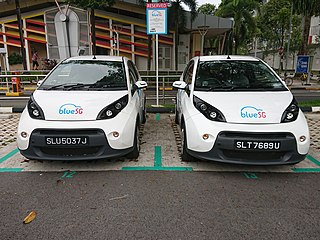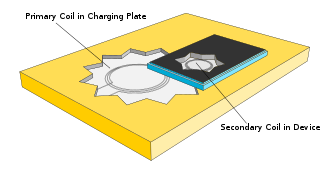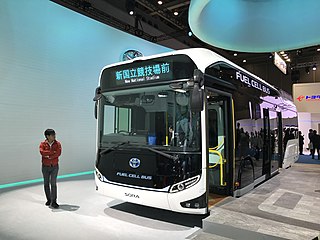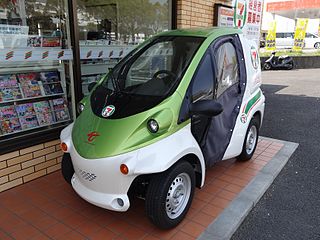
An intelligent transportation system (ITS) is an advanced application which aims to provide innovative services relating to different modes of transport and traffic management and enable users to be better informed and make safer, more coordinated, and 'smarter' use of transport networks.

Carsharing or car sharing or car clubs (UK) is a model of car rental where people rent cars for short periods of time, often by the hour. It differs from traditional car rental in that the owners of the cars are often private individuals themselves, and the car sharing facilitator is generally distinct from the car owner. Car sharing is part of a larger trend of shared mobility.

Sustainable transport refers to ways of transportation that are sustainable in terms of their social and environmental impacts. Components for evaluating sustainability include the particular vehicles used for road, water or air transport; the source of energy; and the infrastructure used to accommodate the transport. Transport operations and logistics as well as transit-oriented development are also involved in evaluation. Transportation sustainability is largely being measured by transportation system effectiveness and efficiency as well as the environmental and climate impacts of the system. Transport systems have significant impacts on the environment, accounting for between 20% and 25% of world energy consumption and carbon dioxide emissions. The majority of the emissions, almost 97%, came from direct burning of fossil fuels. In 2019, about 95% of the fuel came from fossil sources. The main source of greenhouse gas emissions in the European Union is transportation. In 2019 it contributes to about 31% of global emissions and 24% of emissions in the EU. In addition, up to the COVID-19 pandemic, emissions have only increased in this one sector. Greenhouse gas emissions from transport are increasing at a faster rate than any other energy using sector. Road transport is also a major contributor to local air pollution and smog.

A fuel cell vehicle (FCV) or fuel cell electric vehicle (FCEV) is an electric vehicle that uses a fuel cell, sometimes in combination with a small battery or supercapacitor, to power its onboard electric motor. Fuel cells in vehicles generate electricity generally using oxygen from the air and compressed hydrogen. Most fuel cell vehicles are classified as zero-emissions vehicles. As compared with internal combustion vehicles, hydrogen vehicles centralize pollutants at the site of the hydrogen production, where hydrogen is typically derived from reformed natural gas. Transporting and storing hydrogen may also create pollutants. Fuel cells have been used in various kinds of vehicles including forklifts, especially in indoor applications where their clean emissions are important to air quality, and in space applications. Fuel cells are being developed and tested in trucks, buses, boats, ships, motorcycles and bicycles, among other kinds of vehicles.

An automotive navigation system is part of the automobile controls or a third party add-on used to find direction in an automobile. It typically uses a satellite navigation device to get its position data which is then correlated to a position on a road. When directions are needed routing can be calculated. On the fly traffic information can be used to adjust the route.

The i-unit is an ultra-compact single-seater four-wheeled Toyota concept car. It debuted at the World Expo 2005, held in Aichi Prefecture, Japan. The vehicle is a cross between a microcar, a motorcycle, and a vehicular exoskeleton. The goal of Toyota is to provide a personal mobility, which can be used on roads but also does not hinder interaction with pedestrians. For this the i-unit has two possible setups. First, there is an upright low speed setup, where the rider has a higher position and can have conversations face-to-face with pedestrians and can move among people. This upright position can be transformed while driving to a low position, where the rider sits much lower and more reclined. This high speed setup has a much lower center of gravity and is for driving at higher speeds.

A motorized scooter is a stand-up scooter powered by either a small internal combustion engine or electric hub motor in its front and/or rear wheel. Classified as a form of micro-mobility, they are generally designed with a large center deck on which the rider stands. The first motorized scooter was manufactured by Autoped in 1915.
Vehicular ad hoc networks (VANETs) are created by applying the principles of mobile ad hoc networks (MANETs) – the spontaneous creation of a wireless network of mobile devices – to the domain of vehicles. VANETs were first mentioned and introduced in 2001 under "car-to-car ad-hoc mobile communication and networking" applications, where networks can be formed and information can be relayed among cars. It was shown that vehicle-to-vehicle and vehicle-to-roadside communications architectures will co-exist in VANETs to provide road safety, navigation, and other roadside services. VANETs are a key part of the intelligent transportation systems (ITS) framework. Sometimes, VANETs are referred as Intelligent Transportation Networks. They are understood as having evolved into a broader "Internet of vehicles". which itself is expected to ultimately evolve into an "Internet of autonomous vehicles".

Inductive charging is a type of wireless power transfer. It uses electromagnetic induction to provide electricity to portable devices. Inductive charging is also used in vehicles, power tools, electric toothbrushes, and medical devices. The portable equipment can be placed near a charging station or inductive pad without needing to be precisely aligned or make electrical contact with a dock or plug.

An electric vehicle charging network is an infrastructure system of charging stations to recharge electric vehicles. The term electric vehicle infrastructure (EVI) may refer to charging stations in general or the network of charging stations across a nation or region. The proliferation of charging stations can be driven by charging station providers or government investment, and is a key influence on consumer behaviour in the transition from internal combustion engine vehicles to electric vehicles. While charging network vendors have in the past offered proprietary solutions limited to specific manufacturers, vendors now usually supply energy to electric vehicles regardless of manufacturer.

Shared transport or shared mobility is a transportation system where travelers share a vehicle either simultaneously as a group or over time as personal rental, and in the process share the cost of the journey, thus purportedly creating a hybrid between private vehicle use and mass or public transport. It is a transportation strategy that allows users to access transportation services on an as-needed basis. Shared mobility is an umbrella term that encompasses a variety of transportation modes including carsharing, Bicycle-sharing systems, ridesharing companies, carpools, and microtransit.
Toyota Concept Vehicles produced between 2010 and 2019 include:
A connected car is a car that can communicate bidirectionally with other systems outside of the car. This connectivity can be used to provide services to passengers or to support or enhance self-driving functionality. For safety-critical applications, it is anticipated that cars will also be connected using dedicated short-range communications (DSRC) or cellular radios, operating in the FCC-granted 5.9 GHz band with very low latency.
Mobility as a service (MaaS) is a type of service that enables users to plan, book, and pay for multiple types of mobility services through a combined platform. Transportation services from public and private transportation providers are combined through a unified gateway, usually via an app or website, that creates and manages the trip and payments, including subscriptions, with a single account. The key concept behind MaaS is to offer travelers flexible mobility solutions based on their travel needs, thus "mobility as a service" also refers to the broader concept of a shift away from personally-owned modes of transportation and towards mobility provided as a service.

A scooter-sharing system is a shared transport service in which electric motorized scooters are made available to use for short-term rentals. E-scooters are typically "dockless", meaning that they do not have a fixed home location and are dropped off and picked up from certain locations in the service area.

BlueSG is a Singaporean company providing electric car sharing and electric car charging services. Announced in September 2017, the company, a subsidiary of Goldbell, launched the service in December of the same year, with 30 charging stations and 80 all-electric Bolloré Bluecar for public use on a paid subscription basis.

Micromobility refers to a range of small, lightweight vehicles, driven by users personally. Micromobility devices include bicycles, e-bikes, electric scooters, electric skateboards, shared bicycle fleets, and electric pedal assisted (pedelec) bicycles.

Smart Columbus is an innovation organization in Columbus, Ohio. The initiative is led by the City of Columbus and the Columbus Partnership, a nonprofit organization for development in Central Ohio. Smart Columbus was founded in 2016 to utilize $50 million in grant awards toward technology, transportation, and environmental developments.

The Toyota Sora is a transit bus with an electric motor powered by hydrogen fuel cells produced by Toyota, developed in cooperation with Hino Motors. The bus uses components originally developed for the Toyota Mirai, a mid-size fuel cell sedan. The name Sora is an abbreviation of the words Sky, Ocean, River and Air and refers to the water cycle.

The Toyota COMS is a single-seater electric microcar produced by Toyota Auto Body. The first generation was introduced by Araco in 2000. In 2012, Toyota Auto Body launched a second generation.
















